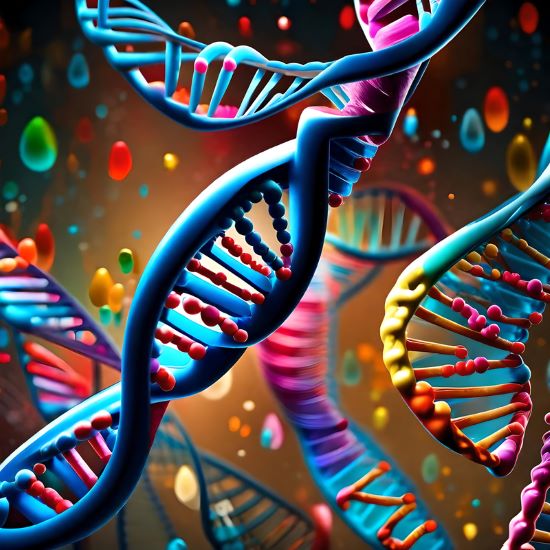The prehistory and history of the human species show that disease and war have played a part in altering the DNA of populations. Disease outbreaks have been transformational. Empires have risen and fallen because of them. Some disease outbreaks have been spurred on by climate change. War has victimized others combining privation with murder. In this article, we look at the Black Death’s impact on European DNA, the Holocaust and its shaping of DNA in Jews today, and what COVID-19 has done to our genes.
The Black Death’s Impact on Human DNA
When the Black Death, also called the Bubonic Plague, struck Europe in the 14th century, from 1346 to 1353 it killed an estimated 50 million which represented nearly 50% of that continent’s population at the time. The bacteria Yersinia pestis was both a killer and a shaper of European evolution. The evidence remains in our DNA to this day.
How did exposure to Yersinia pestis change European populations? Evidence from 200 skeletal remains dated before, during and after the Black Death from London and Danish sites identified up to 245 differentiated genetic variants.
The most notable is the ERAP2 gene responsible for disease detection and the arming of the immune system. It became far more common in the European population after the passing of the pandemic. Individuals with two copies of the ERAP2 protein were 40% more likely to survive the plague because the signalling molecules released in the presence of the plague bacterium incited the body to produce macrophages that killed the Y.pestis bacteria, the cause of the Black Death.
The genetic change is still found in European populations today. An unfortunate consequence of that change is the ERAP2 gene variant that became more dominant has increased the risk for Crohn’s and inflammatory bowel disease, while another gene variant more common after the Black Death is associated with a higher risk for Rheumatoid Arthritis and Systemic Lupus Erythematosus.
The Holocaust, Genetics, Epigenetics and the Jews
The mass murder of European Jews didn’t just occur with Nazi Germany before and during the Second World War. It was preceded by European persecution of Jews living on the continent for many centuries. From the 11th to the 13th century during The Crusades, Jewish communities in Europe vanished through mass killings. These murderous acts altered the genome of European Jews who are called Ashkenazi. Jews in the Middle East, North Africa and India were isolated from their Ashkenazi brethren. They developed distinctive genomic signatures and are called Sephardim.
Discrimination, persecution and mass murder have left elevated genetic markers passed along by the few survivors of the Holocaust in which 6 million Jews perished. These survivors represent the few among the many and in the repopulation of Jews in Europe have passed along amplified genetic variants.
A good example of amplification is how two survivors from Vilna in Lithuania who escaped the massacre of their Jewish neighbours produced in their descendants elevated markers for Canavan disease. This is just one of dozens of Jewish genetic diseases that run from Alport to Zellweger Syndrome and represent the legacy of repeated persecution and murders.
Today, modern Ashkenazi derive from as few as 350 survivors from The Crusades. Their genome when compared to other ethnic groups is largely homogeneous. Before the Holocaust Jewish genetic diversity in Europe wasn’t akin to different population groups. After the Holocaust, genetic diversity lessened. Before it, Ashkenazi Jews accounted for 92% of the world’s population. After that, the number dropped well below; in the past 80 years, the numbers have never completely made up the difference. Today, Ashkenazim represent 80% of the world’s Jews.
In some cases, genetic disorders among Ashkenazi Jews are less prevalent than before the Holocaust. In the case of the survivors of Vilna, however, the genetic bottleneck has passed on traits and mutations which have negative consequences.
The Holocaust has produced interesting research looking at epigenetic effects on population groups from environmental stresses. Recent epigenetic studies of Holocaust families show environmentally forced changes in survivors and their children. The changes are in the FKBP5 gene associated with Post Traumatic Stress Disorder (PTSD), depression, and anxiety. The exposure to trauma has caused genetic methylation, the addition of methyl groups to DNA affecting gene expression without altering the underlying sequence. Severe trauma experienced during the Holocaust, therefore, has had and continues to have a pronounced biological impact persisting for generations.
Similar methylation occurrences have been observed from World War Two acts by Nazi Germany. During the occupation of The Netherlands, the Dutch experienced a Hunger Winter from 1944 to 1945. The children born to mothers pregnant at the time exhibited increased rates of obesity, diabetes and cardiovascular disease which has then been passed along to subsequent generations.
Another historic example occurred during China’s Cultural Revolution from 1966 to 1976. Victimized populations show changes in the expression of the FKBP5 gene. Similarly, the 1994 Rwandan Genocide caused epigenetic changes in survivors and their children affecting immune function and stress response.
COVID-19’s Impact on Human DNA
We as of yet don’t know the full impact that the COVID-19 pandemic will have on human genetics. Research being done presently indicates a few key areas where our genetics will have been altered. These include:
- Studies currently being done that indicate certain genetic variants are associated with a higher risk of getting severe responses to COVID-19. These genetic variants appear to have been inherited from ancestral Neanderthal DNA and non-African populations.
- Evidence that COVID-19 induces DNA damage through mechanisms like oxidative stress. Oxidative stress causes apoptosis, the signalling to cells to cease dividing leading to their death.
- Research that is studying the potential for COVID-19 DNA to integrate into human DNA, permanently altering it.
- Epigenetic impacts that may lead to increased risk of infections from other chronic diseases in recovered patients, those experiencing Long COVID, and their descendants.
- Speculation on the long-term effect of large-scale deaths from COVID-19 and its altering effect on human genetic variation.
On this last point, it seems less significant if you only consider the total direct number of deaths which is a little over 7 million. The more interesting number, however, is the total who contracted the virus. That number has reached 775 million or 9.5% of the world’s population. Then there are the 10 to 20% of cases where people have experienced or continue to suffer from Long COVID symptoms. I suspect we will see several epigenetic studies published in the next few years.









